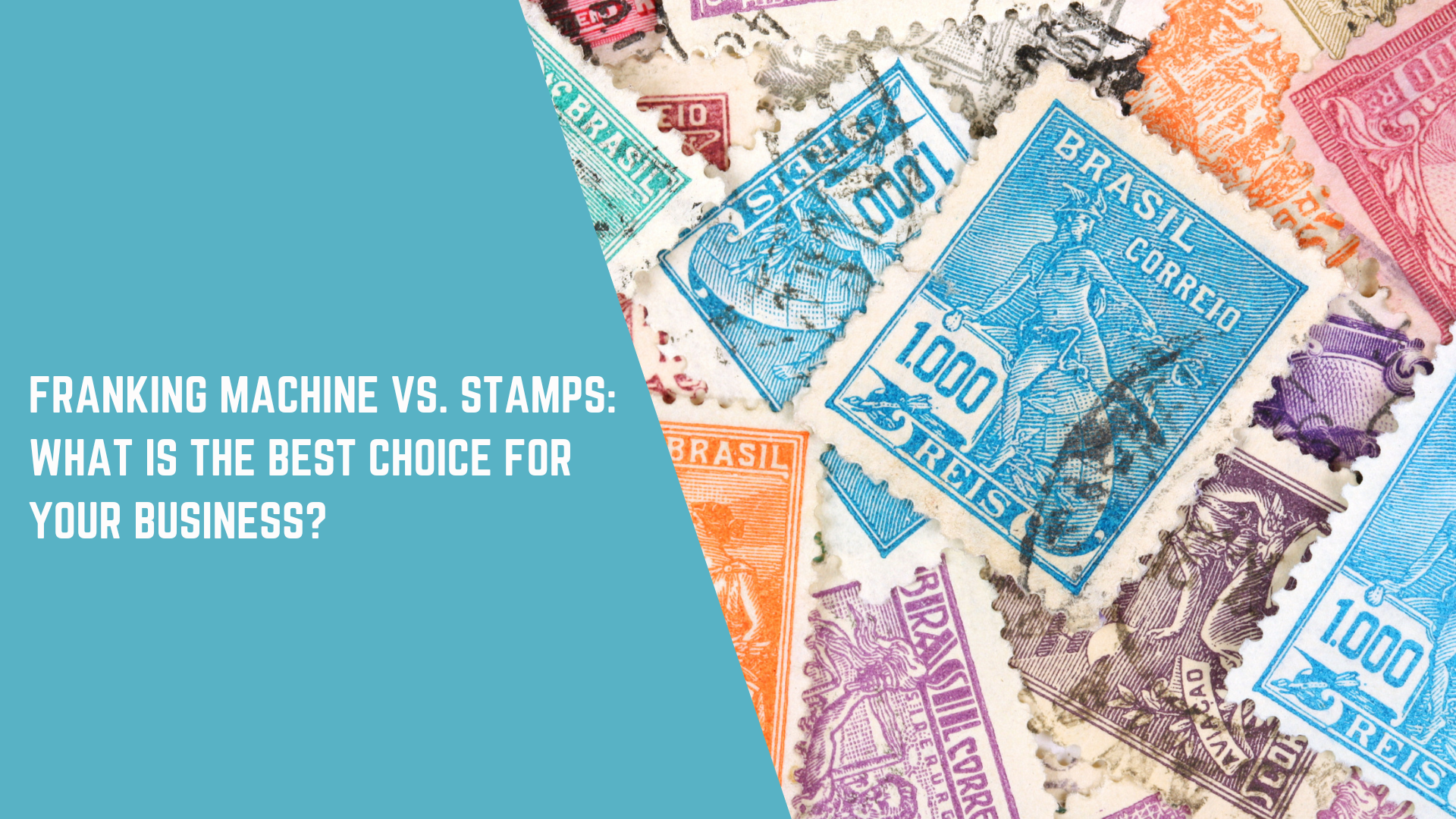Should you use a franking machine, or just stick to stamps?
Before we delve into a detailed comparison between franked mail and stamped mail, it is crucial to understand the concept behind each postage option, as this is vital in making a decision that is best suited for your business mailing needs.
With imail comms, you can say hello to optimised communication.
Stamped Mail
Stamped mail is a customary method of sending mail in the UK that has been commonly used throughout the years. Stamps are usually purchased from a post office and are manually applied to your letter or parcel before postage.

Franked Mail
This type of postage refers to mail with a Mailmark Indica comprised of a 2D barcode that is printed directly onto envelopes, parcels, and adhesive labels. This blue franking mark is an alternative to stamping and can be generated using a mail mark franking machine, which can also add features like return address, marketing messages, and company logos that strengthen the professional image of your business.

How does a franking machine work?
To put it simply, a franking machine is essentially a piece of equipment that prints money in the form of postage. The franking machine weighs the item that will be sent, determines the postage price and prints the generated details on your mail item. All printed details correspond to a Royal Mail account that you need to initially set up, with postage costs eventually deducted from the account balance.
Stamps Vs. Franking: A Cost Comparison
Nowadays, franking is becoming a more enticing option for most businesses in the UK. This is due to the constant reduction in prices of franking and the discounts consistently offered by the Royal Mail when opting for this service. These franking prices essentially deem stamp prices more costly and reduce traffic on stamp services.
1st Class Mail Royal Postal Rates Comparison

2nd Class Royal Mail Postal Rates Comparison

At first glance, the price difference between stamped and franked mail may seem nominal. However, these small differences in costs equate to considerable amounts when accumulated, especially if your business sends a large volume of mail to its customers. For an insight on how a business can save money with franking, we will compare the incurred cost for a business sending letters using a franking machine in contrast to using stamps.
If we assume a business sends out an average of 500 (250g) large letters per month with Royal Mail, we can determine the cost difference per class letter as follows:
1st Class Letter
First Class Stamps: 2.25
1st Class Mailmark Franking: 1.95
Price Difference Per Letter/Parcel = 0.41
Annual Savings: £1800
2nd Class Letters
Second Class Stamps: 1.85
2nd Class Mailmark Franking: 1.44
Price Difference Per Letter/Parcel = 0.41
Annual Savings: £2460
Many businesses may neglect to see the advantages of franking machines when comparing franking and stamp prices individually. However, in a long-term perspective, the cumulative annual savings with franking services are significantly worthwhile. Remember, when using a franking machine, sending a parcel becomes more cost-effective with larger quantities your business sends to customers and vice versa.
Should My Business Invest in a Franking Machine?
Standard Franking machines can be either rented from Royal Mail or any of their supply partners, or they can be purchased permanently to keep at your business premises. With that in mind, investing in a franking machine is advisable for businesses that:
- Send large rather than low volumes of parcels/packages with Royal Mail.
- Prioritise client personalisation and untraditional advertising through mailed parcels.
- Seek to save money and time with each mailed-out parcel.
- Have been relying on stamp services for its mailing needs. Keep in mind, small changes are key to growth!

Which Franking Machine is Most Suitable for My Business?
If you are wondering about franking machine prices or have sought out to purchase a franking machine, you may have realised that there is a vast range of franking machines in terms of size, speed and functionality. Selecting franking machines that are best suited for your business can be tricky, but rest assured as you can find all your franking answers in our definitive guide to franking machines.
Useful Tip – Utilise Royal Mail franking services tool to find authorised suppliers of franking machines and parcel franking service provides.
Franking Machine Types
Let’s take a look at some of our favourite franking machines for any business!
Neopost IN-360
The Neopost IN-360 franking machine stands out for its ease of use and efficiency, making it ideal for small to medium-sized businesses. It automates mail processing, saving time and money. However, its initial cost and maintenance fees can be high, and it may offer more features than a small business needs.
Frama Matrix-F42
The Frama Matrix-F42 franking machine is lauded for its precision and reliability, catering well to medium-sized enterprises. It offers a user-friendly interface and robust security features. On the downside, the machine’s higher acquisition price and the specific training required for optimal operation might deter some businesses from adopting it.
IS-40 Mailmark KCMS
The IS-40 Mailmark KCMS franking machine is renowned for its integration with Royal Mail’s Mailmark technology, ensuring the lowest postage rates and accurate tracking. Its compact size suits small office spaces. However, the machine’s limited capacity may not meet the demands of larger businesses with higher volume mailing needs.
Final Thoughts
In summary, businesses can benefit from switching to franked mail postage and investing in a franking machine, especially if they send large volumes of mail and value cost savings, efficiency, and additional features like personalised correspondence. Franked mail not only offers financial advantages through discounted postal rates but also enhances operational efficiency by streamlining the mail handling process. The ability to track and report postage expenses facilitates better budget management.
Also, the personalisation capabilities of franking machines—such as printing company logos or promotional messages on envelopes—provide a unique opportunity to reinforce brand identity with every piece of mail sent. While the initial investment and maintenance costs may seem daunting, the long-term savings, improved workflow, and branding benefits present a compelling case for businesses to adopt franked mail as a cost-effective and professional mailing solution.
Frequently Asked Questions (FAQ’s)
Here are the answers people want when comparing franking machines and stamps.
What are the benefits of using a franking machine compared to stamps?
Using a franking machine over traditional stamps offers several benefits for businesses. Firstly, it provides significant cost savings due to lower postage rates for franked mail. Additionally, franking machines streamline the mailing process, saving time and improving efficiency. They also allow for precise postage calculation, reducing the risk of over or underpaying. Also, franked mail can be customised with your business logo or messages, enhancing brand visibility. Lastly, franking machines offer tracking and reporting features, aiding in effective mail management and budgeting.
Related: What are the Advantages of Using a Franking Machine?
What is the difference between stamped and franked?
The primary difference between stamped and franked mail lies in how postage is paid and indicated. Stamped mail uses physical stamps purchased and affixed to each item, reflecting pre-paid postage. In contrast, franked mail employs a franking machine to print a postage mark directly onto the mail or a label, indicating payment. Franked mail offers cost savings, efficiency, and branding opportunities, while stamped mail is more traditional and might be preferred for lower volumes of mail.
Is it cheaper to use a franking machine?
Yes, using a franking machine is generally cheaper than using stamps. Franking machines qualify for lower postal rates from Royal Mail, offering significant savings, especially for businesses with high volumes of mail. Additionally, they eliminate the risk of overpaying for postage, ensuring you only pay the exact amount required.
Why is it called ‘franking’?
The term ‘franking’ originates from the Latin word ‘francus’, meaning free. Historically, it referred to the right of sending mail without payment, granted to certain individuals or organisations. Today, it signifies the process of pre-paying postage and marking mail as such, using a franking machine to indicate that postage has been paid.






Leave A Comment
You must be logged in to post a comment.